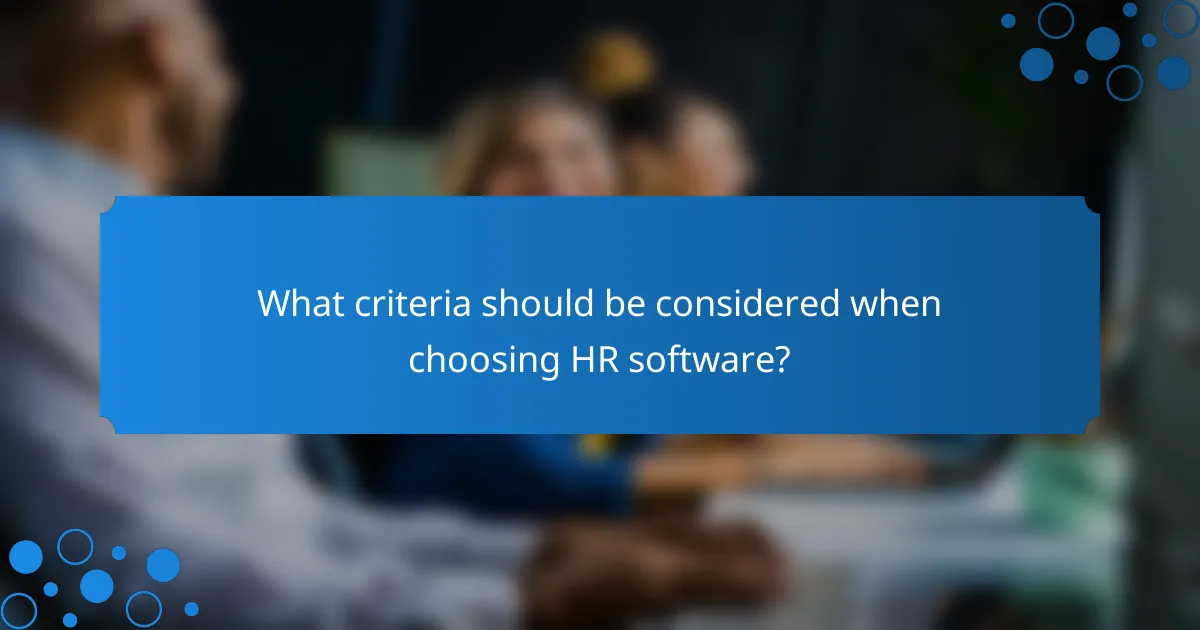Human Resource Management plays a crucial role in enhancing organizational efficiency through effective employee onboarding, performance tracking, and payroll processing. Streamlining these processes not only improves new hires’ experiences and boosts retention but also aligns individual performance with company goals while ensuring compliance and accuracy in payroll operations.

How to streamline employee onboarding in the UK?
Streamlining employee onboarding in the UK involves simplifying and automating the process to enhance new hires’ experiences and improve retention. Effective onboarding can reduce time-to-productivity and foster engagement from day one.
Utilize BambooHR for automated onboarding
BambooHR offers an automated onboarding solution that helps HR teams manage new hire paperwork and training schedules efficiently. By using this platform, companies can create a consistent onboarding experience that ensures all necessary documents are completed before the employee’s first day.
Consider setting up automated reminders for new hires to complete their tasks, which can significantly reduce administrative burdens. This allows HR personnel to focus on more strategic aspects of onboarding, such as cultural integration and team introductions.
Implement Workable for recruitment workflows
Workable is a recruitment software that streamlines the hiring process, making it easier to track candidates and manage job postings. By integrating Workable into your onboarding process, you can ensure a smooth transition from recruitment to onboarding.
Utilize features like collaborative hiring and candidate feedback to enhance decision-making and speed up the recruitment cycle. This can lead to quicker onboarding times, as the right candidates are selected and prepared for their new roles more efficiently.
Leverage employee onboarding checklists
Employee onboarding checklists are essential tools that help ensure all necessary steps are completed during the onboarding process. These checklists can include tasks like setting up IT accounts, scheduling training sessions, and introducing new hires to team members.
Creating a standardized checklist can help maintain consistency across different departments and roles. Regularly review and update the checklist to reflect any changes in company policy or onboarding procedures, ensuring it remains relevant and effective.
![]()
What are effective performance tracking methods?
Effective performance tracking methods include continuous feedback systems, goal-setting frameworks, and progress monitoring tools. These approaches help organizations assess employee performance in real-time, align individual objectives with company goals, and foster a culture of accountability.
Use 15Five for continuous feedback
15Five is a performance management tool that emphasizes regular check-ins and feedback between employees and managers. It allows for weekly updates where employees can share their accomplishments, challenges, and goals, fostering open communication.
To implement 15Five effectively, encourage managers to provide constructive feedback during these check-ins. This can enhance employee engagement and help identify areas for improvement. Aim for a balance of positive reinforcement and developmental feedback to maintain motivation.
Implement OKRs with Betterworks
Betterworks is designed to facilitate the implementation of Objectives and Key Results (OKRs), a goal-setting framework that aligns individual performance with organizational objectives. This method encourages employees to set ambitious goals and track their progress through measurable outcomes.
When using Betterworks, ensure that OKRs are specific, measurable, and time-bound. Regularly review progress during team meetings to keep everyone accountable. This approach not only clarifies expectations but also drives performance through shared accountability.
Track employee goals with Lattice
Lattice provides a platform for tracking employee goals and performance metrics, allowing organizations to visualize progress over time. It integrates feedback, performance reviews, and goal management into one cohesive system.
To maximize the effectiveness of Lattice, encourage employees to set personal development goals alongside team objectives. This dual focus can enhance motivation and foster a culture of continuous improvement. Regularly update goals based on performance reviews to keep them relevant and challenging.

How to optimize payroll processing in the UK?
To optimize payroll processing in the UK, businesses should focus on automation, integration, and compliance. Streamlining these processes can reduce errors, save time, and ensure adherence to legal requirements.
Adopt Gusto for payroll automation
Gusto is a powerful tool for automating payroll tasks, making it easier for UK businesses to manage employee payments. With features like automatic tax calculations and direct deposit, Gusto minimizes manual input and reduces the risk of errors.
Implementing Gusto can lead to significant time savings, allowing HR teams to focus on strategic initiatives rather than administrative tasks. Additionally, Gusto offers user-friendly interfaces that simplify the onboarding process for new employees.
Utilize Xero for integrated payroll solutions
Xero provides an integrated payroll solution that connects seamlessly with accounting and financial management tools. This integration allows for real-time tracking of payroll expenses and simplifies financial reporting.
By using Xero, businesses can streamline their payroll processes, ensuring that all financial data is synchronized. This can help in maintaining accurate records and making informed financial decisions without the hassle of manual reconciliations.
Ensure compliance with UK payroll regulations
Compliance with UK payroll regulations is crucial for avoiding penalties and ensuring fair treatment of employees. Businesses must stay updated on tax rates, National Insurance contributions, and other legal obligations.
Regularly reviewing payroll practices against HM Revenue and Customs (HMRC) guidelines can help maintain compliance. Consider conducting periodic audits and training for payroll staff to ensure they are aware of any changes in legislation.

What criteria should be considered when choosing HR software?
When selecting HR software, consider integration capabilities, user experience, and interface design. These criteria ensure the software meets your organization’s needs and enhances overall efficiency.
Evaluate integration capabilities
Integration capabilities refer to how well the HR software connects with other systems, such as payroll, performance tracking, and onboarding tools. Look for software that supports popular integrations with existing applications to streamline processes and reduce data entry errors.
Check if the software offers APIs or pre-built connectors for seamless data transfer. A good integration can save time and improve accuracy, making it easier to manage employee information across platforms.
Assess user experience and interface
User experience (UX) and interface design significantly impact how effectively employees and HR staff can use the software. A clean, intuitive interface can reduce training time and increase user adoption rates.
Consider conducting user testing or trials to gauge how easily your team can navigate the software. Look for features like customizable dashboards and mobile access, which can enhance usability and accessibility for all users.

How to enhance employee engagement through HR tools?
Enhancing employee engagement through HR tools involves utilizing technology to foster communication, gather feedback, and streamline processes. Effective tools can create a more connected workplace, leading to higher morale and productivity.
Incorporate employee surveys with SurveyMonkey
Using SurveyMonkey for employee surveys allows organizations to gather valuable insights directly from their workforce. This tool enables HR teams to create customized questionnaires that can assess job satisfaction, engagement levels, and areas for improvement.
To maximize effectiveness, consider conducting surveys quarterly or biannually, ensuring anonymity to encourage honest feedback. Analyze the results to identify trends and implement changes that address employee concerns, which can significantly boost engagement.
Use Slack for team communication
Slack is a powerful platform for enhancing team communication and collaboration. By creating dedicated channels for different projects or departments, employees can easily share updates, ask questions, and collaborate in real-time, fostering a sense of community.
To enhance engagement, encourage teams to use Slack for both work-related discussions and social interactions, such as virtual coffee breaks or team-building activities. This balance can help maintain a positive work culture and strengthen relationships among colleagues.

What are emerging trends in HR technology?
Emerging trends in HR technology focus on enhancing employee experience, streamlining processes, and leveraging data analytics for better decision-making. Key developments include automation, artificial intelligence, and cloud-based solutions that improve onboarding, performance tracking, and payroll processing.
Automation in Employee Onboarding
Automation in employee onboarding simplifies the process by using software to handle repetitive tasks such as document collection and training scheduling. This allows HR teams to focus on more strategic activities while ensuring a consistent experience for new hires.
For example, automated onboarding platforms can send welcome emails, provide access to necessary documents, and schedule orientation sessions without manual intervention. This can reduce the time spent on onboarding by up to 50%.
Performance Tracking Innovations
Innovations in performance tracking utilize real-time feedback and data analytics to assess employee performance continuously. This shift from annual reviews to ongoing assessments helps organizations identify strengths and areas for improvement more effectively.
Tools like performance management software can facilitate regular check-ins and goal-setting, allowing employees to receive timely feedback. This approach fosters a culture of continuous improvement and engagement.
Streamlined Payroll Processing
Streamlined payroll processing leverages technology to automate calculations, tax deductions, and compliance with local regulations. This reduces errors and ensures timely payments, which is crucial for employee satisfaction.
Modern payroll systems can integrate with other HR functions, providing a unified platform for managing employee data. Companies can save significant time and resources by adopting cloud-based payroll solutions, which often come with user-friendly interfaces and robust reporting capabilities.